|
Getting your Trinity Audio player ready...
|
Established in 1928
Bryce Canyon’s captivating landscape of limestone spires, slot canyons, and unique hoodoos will capture your heart and your imagination. Red and orange spires called hoodoos that early Native Americans believed to be cursed spirits, tower through the sky.
They say big things come in small packages. When you get an idea of how much one-of-a-kind desert magic Bryce Canyon has to offer, despite being the smallest National Park in Utah, you’ll believe it. In a nutshell, Bryce is a forest of needle-thin spires, or hoodoos, formed in wide open amphitheaters.
Descending from the top of the Paunsagunt Plateau above 9,000 feet, Bryce Canyon drops rapidly just over 2,000 feet. This is harsh country – steep slopes walled by mazelike channels through the multicolor dirt etch narrow paths down and around the plateau. Ponderosa pines grow tall in tiny crevices between skyward towers striped in brown, pink, red, yellow, orange, purple, and white.
Bryce Canyon is at its very best when taken in from a distance. Arguably, one of the best ways to visit the park is to drive the rim and take time to enjoy all of the scenic panoramas along the way. But for the adventurous, you can trek your way across just about all of the park. It’s a place to bask in, to just sit and be awestruck by. It’s enchanting, it’s captivating, it’s something that should be on everyone’s bucket list. In fact—
It’s worthy of more than a little praise. We got so carried away just thinking about Bryce Canyon that we decided to put together this guide to visiting the park. The reasons to go, what makes it so incredible, and the best ways to enjoy it. Consider this our love letter to Bryce Canyon National Park.
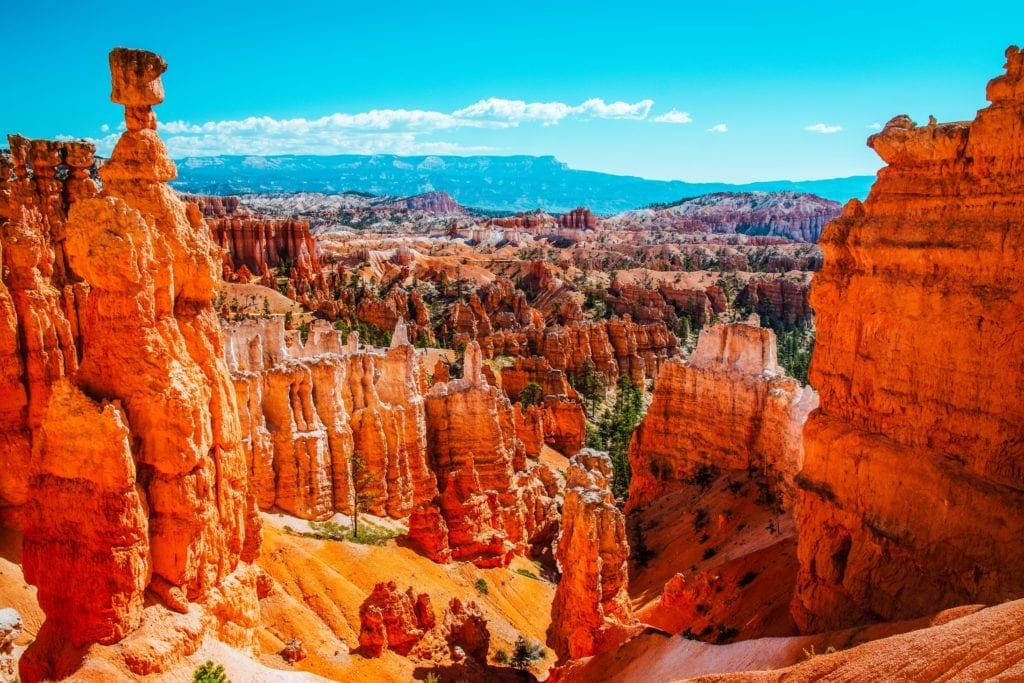
Bryce Canyon National Park at Navajo Loop Trail, Utah.
Looking For An Amazing Adventure? Book A Guided, Multiday Hiking Adventure in Bryce Canyon National Park with REI Adventures. Hike the Southwest’s scenic and exhilarating trails, learning about ancient cultures and Utah’s geological and natural history from REI’s guides.
Table of Contents:
Article Navigation: Click on any of the listed items in the table of contents below to jump to that section of the article. Similarly, clicking on any large, white section header will jump you back to the Table of Contents.
- Human History
- Geology, Summarized
- A Thriving Desert Ecosystem
- Where to Stay
- Main Attractions
- Treat Yourself To A Guided Adventure
- A Living Landscape
Human History
Compared to other parts of Southern Utah, we know very little about the ancient human history of Bryce Canyon National Park. Despite abundant evidence of humans living in the surrounding area as far back as 10,000 years ago, there isn’t a whole lot of evidence of prehistorical human habitation of Bryce. Presumably, Ancestral Puebloan and Fremont Native peoples lived in the area until their mysterious disappearance some 700 years ago.
Nature sculpted red and orange spires, the hoodoos, in Bryce Canyon over millions of years. The Paiute natives believe they are Legend People transformed to stone by Coyote, the trickster god.
Around this time, modern Southern Paiute natives moved into the area surrounding Bryce Canyon. The hoodoos of Bryce Canyon played a prominent role in Paiute stories and beliefs. According to legend, the hoodoos were formed when the To-when-an-ung-wa, the inhabitants who once roamed the land before humans, failed to pay proper respect to their environment. Coyote, the trickster god, punished them for this negligence by transforming them into stone. This explains the name Angela-ku-wass-a-wits, which translates to “red painted faces”.
Because of the area’s remoteness and the difficulty of the terrain, European settlers didn’t reach Bryce Canyon until the early 1800’s. The first major exploratory expedition into the area was headed up by Major John W. Powell, who surveyed the Sevier and Virgin Rivers on his second historical voyage down the Colorado River.
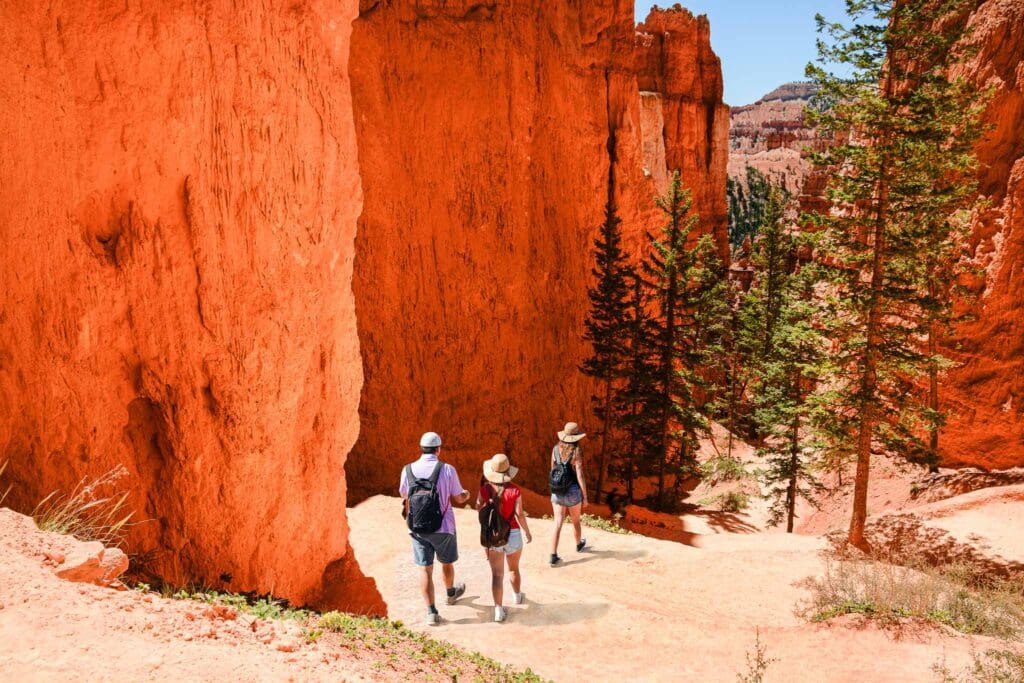
Hikers on Navajo Loop Trail in Bryce Canyon National Park, Utah.
Later, the Mormon Settlers sent Scottish immigrant Ebenezer Bryce and his wife Mary to settle the Paria Valley. When Bryce arrived, he situated his homestead right underneath the Bryce Amphitheater. He dug an irrigation canal from Paria Creek to his home and made a road into the amphitheater above to ease the work of collecting timber.
Settlers in the surrounding area began to refer to the amphitheater as “Bryce’s Canyon”, and the name stuck. Bryce, who was a originally a carpenter, grazed cattle in what would later become the park. He was quoted saying that the rugged amphitheaters above his homestead were a “helluva place to lose a cow”.
Interest in Bryce Canyon’s natural beauty began to spark in the early 1900’s. Visitation remained low for a time due to the effort required to get to Bryce Canyon, but was completely unsupervised by any governing body. Conservationists were becoming increasingly concerned about the impacts of unchecked grazing, timber harvest, and recreation on the fragile landscape. These issues were elevated quickly, and in 1923 President Warren G. Harding named Bryce Canyon a National Monument and was redesignated as a national park by Congress in 1928. In 1931, President Hoover increased the size of the park to its current 35,835 acres.
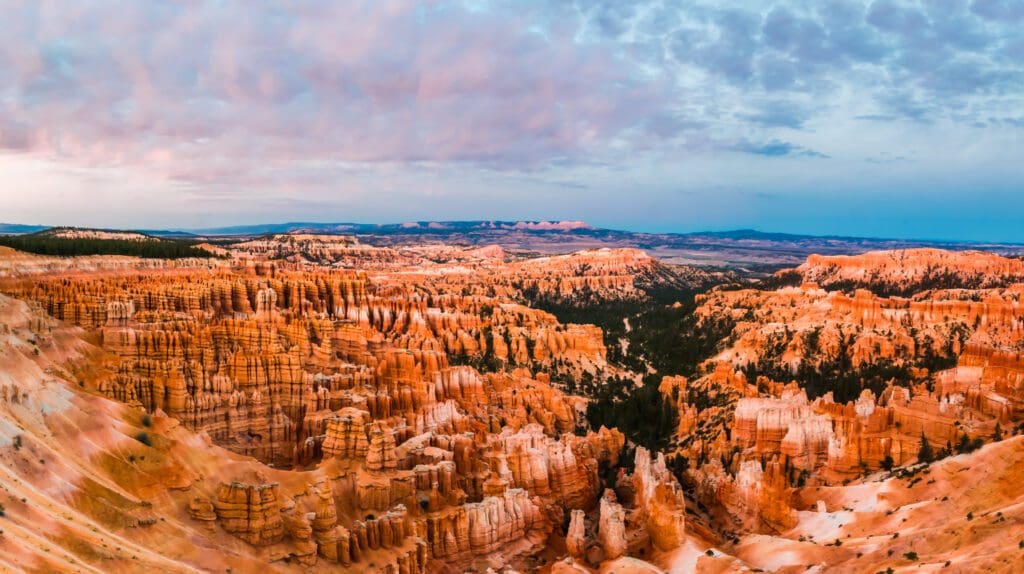
Bryce Amphitheater is a “helluva place to lose a cow”. Photo taken Inspiration Point at sunset by Billy McDonald/Adobe Stock.
The Ultimate Offline GPS Hiking & Ski Maps
See why onX Backcountry is the ultimate GPS navigation app for your outdoor pursuits. Try Today for Free. No credit card required.
Geology, Summarized
Bryce Canyon features many of the same geological marvels that can be seen around Utah: hoodoos, arches, and natural bridges all exist here. However, they form through different processes than those found in places like Arches National Park. The formations in the park are formed by headward erosion, and are essentially exaggerated badlands.
What this means is that the main action of erosion happens as groundwater seeps out of the plateau, pulling the loose soil of the underlying Claron Formation with it. As the soft earth falls away, it leaves behind the crumbly towers we see around the park. With the addition of further wind erosion, arches can form. The action of headward erosion pushes steadily back into the plateau, rather than cutting down through it. The park is made up of several different drainages along the plateau where water trickles down into creek beds, and thus the name Bryce “Canyon” is actually a misnomer. On a larger scale, the park is made up of a chain of rounded amphitheaters that deepen with each passing year.
Zooming out even more, we can see that the park sits at the top of the Grand Staircase. This massive downward-trending geological stepladder that leads all the way into Grand Canyon National Park. The Grand Staircase allows us to see all of the layers of sedimentary rock that make up the diversity of the southwest, stacked on top of each other. And Bryce Canyon represents the top layer of this red-orange cake of rock and dirt.
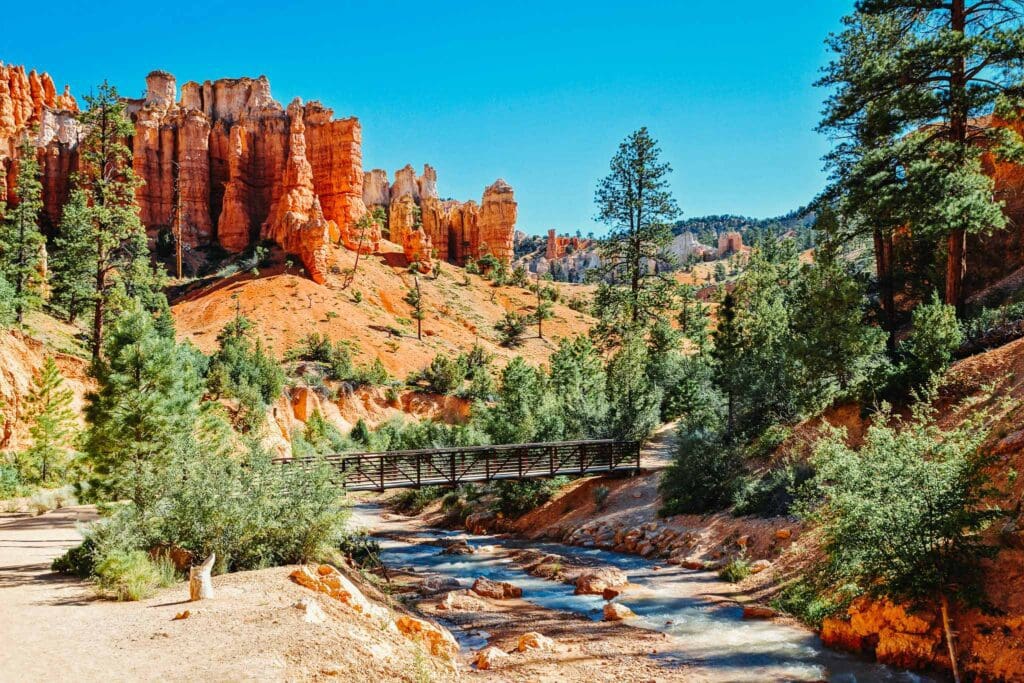
Mossy Cave Trail among the hoodoos in Bryce Canyon National Park.
Support Skyblue Overland™ on Patreon!
If you’d like to support our efforts for a few dollars a month, please subscribe to our Patreon page. Every donation energizes our team to keep writing detailed trail reviews, gear reviews and adventure guides. Thank you!
A Thriving Desert Ecosystem
The ecological diversity of Bryce Canyon National Park is astounding. There are over 400 species of plants found in the park, making up several distinct ecological niches and varying from desert-typical shrubs and trees to wetland plants and trees more commonly found in high elevation mountains. In fact, it’s the extreme gradient of elevation (as well as cryptobiotic soil) across the park that creates this diversity of plants and animals.
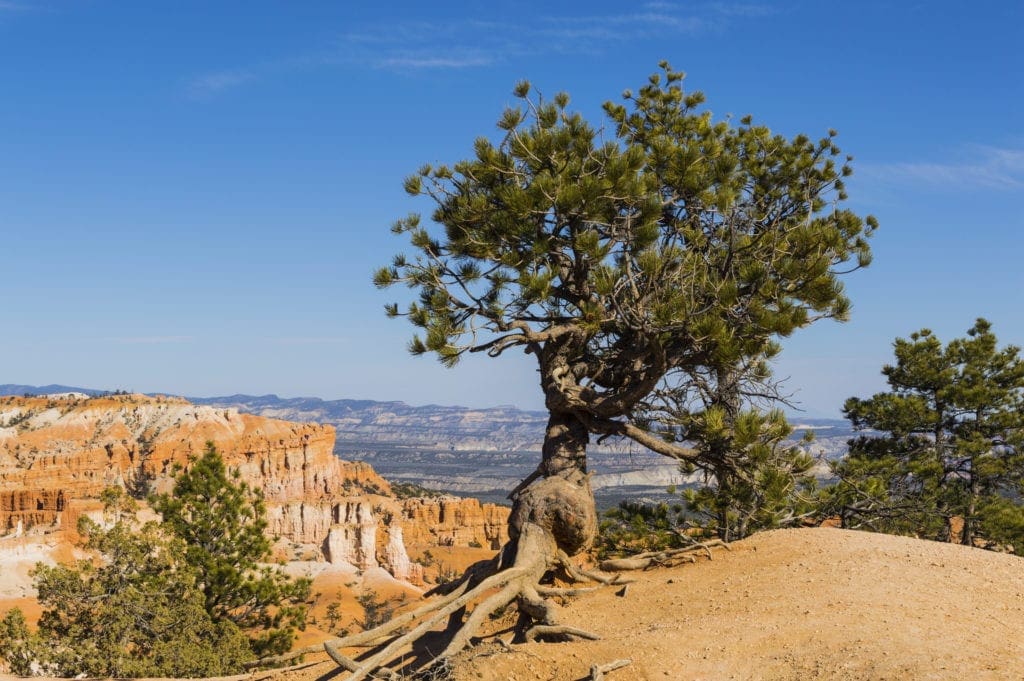
A lone Bristlecone Pine silhouetted against blue sky at Bryce Canyon on a beautiful Spring day.
Bryce Canyon is divided into three different “life zones”. In the lowest elevations are plants you would expect to see in a desert – piñon pine, juniper, and shrubs. Near running water you may see leafy trees like aspen, cottonwood, and willows. Further up, the plant community transitions into one dominated by large ponderosa pines, along with blue spruce and some douglas firs. Higher still, the plants you’ll see resemble more of a mountainous ecosystem: douglas fir, white fir, and englemann spruce live on the slopes.
In the harshest corners of the park, hardy trees like limber pine and bristlecone pine cling to exposed outcroppings. Bristlecone pines are famously the longest living organisms on earth, and the ones found in Bryce are as old as 1,600 years. Spot them on the Fairyland Loop and Bristlecone Loop trails.
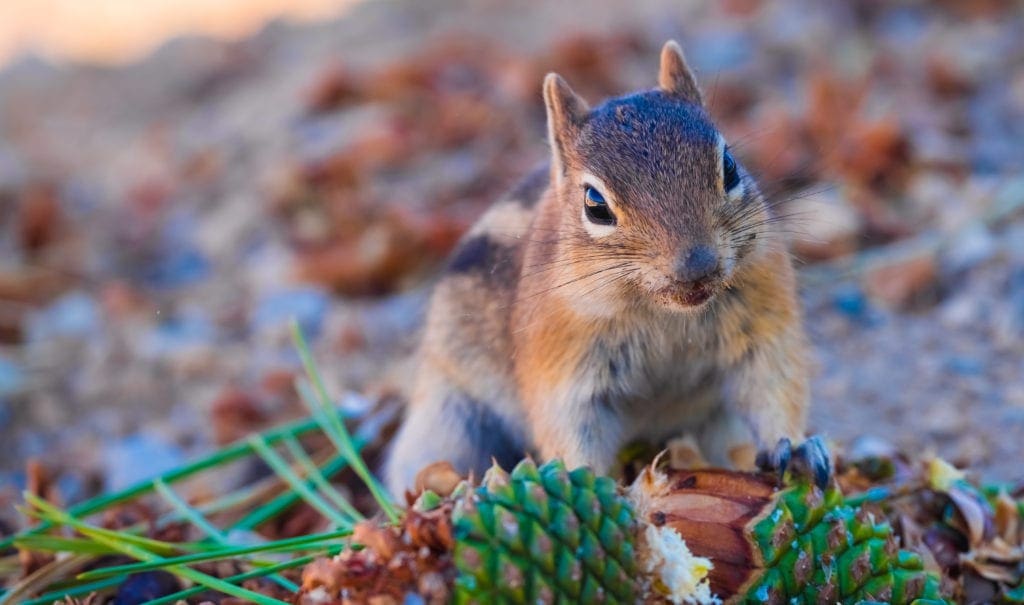
Uinta Chipmunk eating the seeds of coniferous trees along the rim of the Bryce Canyon National Park, Utah, USA
Under this patchwork canopy of plants, a thriving community of animals crawls, hops, and slithers. Surprisingly, the ecological community of animals in Bryce Canyon is mostly dominated by mammals. You can commonly see mule deer, foxes, coyotes, badgers, porcupines, pronghorn, and even elk in the park. There are also black bears, bobcats, and cougars that do quite well in Bryce. This diverse community of mammals is due to the park’s elevation and the availability of water, which is much more here than in lower deserts.
California condors, woodpeckers, eagles, owls, swifts, swallows, and many more birds all find nooks and crannies to nest in among the cliffs and huge pines. The diversity of tree species, as well as the large cliff walls provide nesting sites for a wide variety of bird species. And of course, the image of arid desert hillsides would be incomplete without reptiles. Rattlesnakes, short-horned lizards, and whipsnakes are common in Bryce Canyon. Even some amphibians can be found in the wetter parts of the park, like the tiger salamander.
This huge diversity of plants and animals makes Bryce a hub for birdwatchers and nature enthusiasts. Walking through Bryce on any given day you can see most of the incredible natural diversity of the West all in one place.
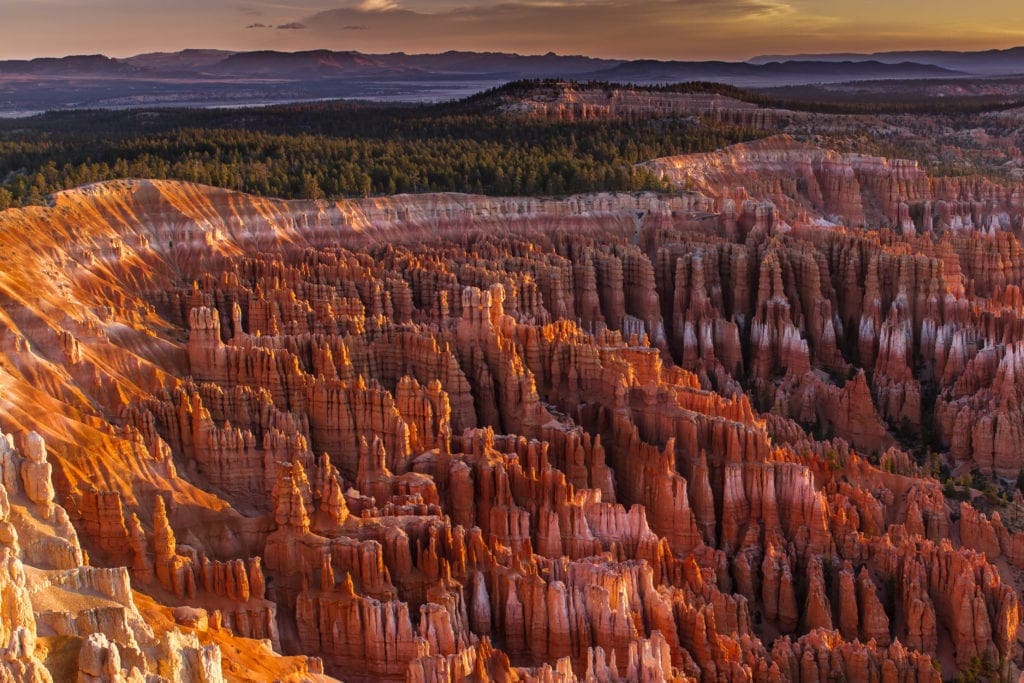
The Silent City is a natural amphitheater made of desert hoodoos in Bryce Canyon National Park, Utah.
Where To Stay
Bryce Canyon Lodge: Constructed during the booming 1920s railroad era, the Bryce Canyon Lodge is an exemplary example of Western “parkitecture,” with its stone walls, wooden trusses, and dark-green shingled roof. Visitors can get cozy in front of the large stone fireplace within the timber-framed lobby, kick back in hickory rockers on the porch, or snack on a classic bison burger. Accommodations consist of limited studios and hotel rooms, as well as cabins which come complete with their own fireplace.
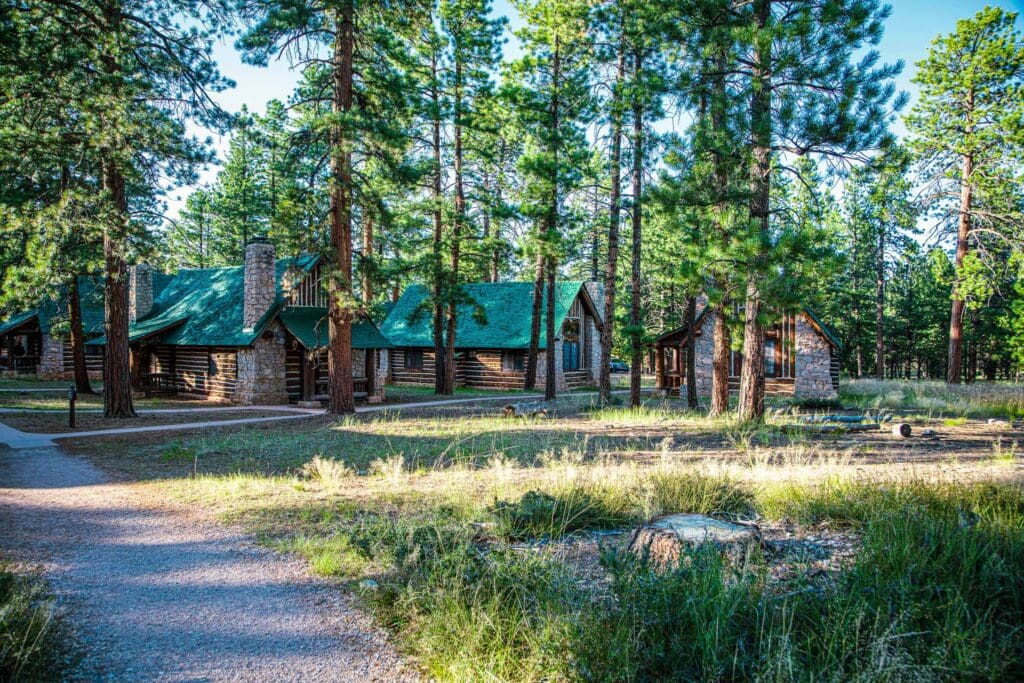
Adorable rustic style green-roofed log cabins are part of the Bryce Canyon Lodge.
Ruby’s Inn: Ruby’s Inn is a vast, eco-certified complex situated just a mile north of the national park entrance. It has been inviting guests for over 100 years now and offers more than 400 motel rooms, a campground, a grocery store, two gas stations, restaurants and an outdoor pool. This Best Western hotel can arrange tours to suit your needs, be it ATVing, horseback riding, airplane tours, hiking or sleigh rides.
North Campground: This is a year-round site with 100 pitches set amongst the pines. There are four loops (A, B, C and D) established, two for RV campers and two for tents (but tents are allowed in all of them). No power, water or sewage hook-ups are available. During summer months, there is a dump station nearby which comes with the campsite fee. Potable water can also be accessed at the dump station. This location is conveniently close to the Visitor Center, General Store, and Fairyland Loop/Rim Trail.
Sunset Point Campground: About a mile and a half south of the Bryce Canyon Visitor Center, this campground has three loops with ninety-nine sites. Loop A is mainly for recreational vehicles while Loops B and C are only for tents. There are no sewer, water or electricity hookups. During the summer, there’s a dump station near North Campground; use is free with the campsite fee. You can find potable water nearby as well. Lastly, Sunset Campground is right by Sunset Point and it has a shuttle stop at its entrance.
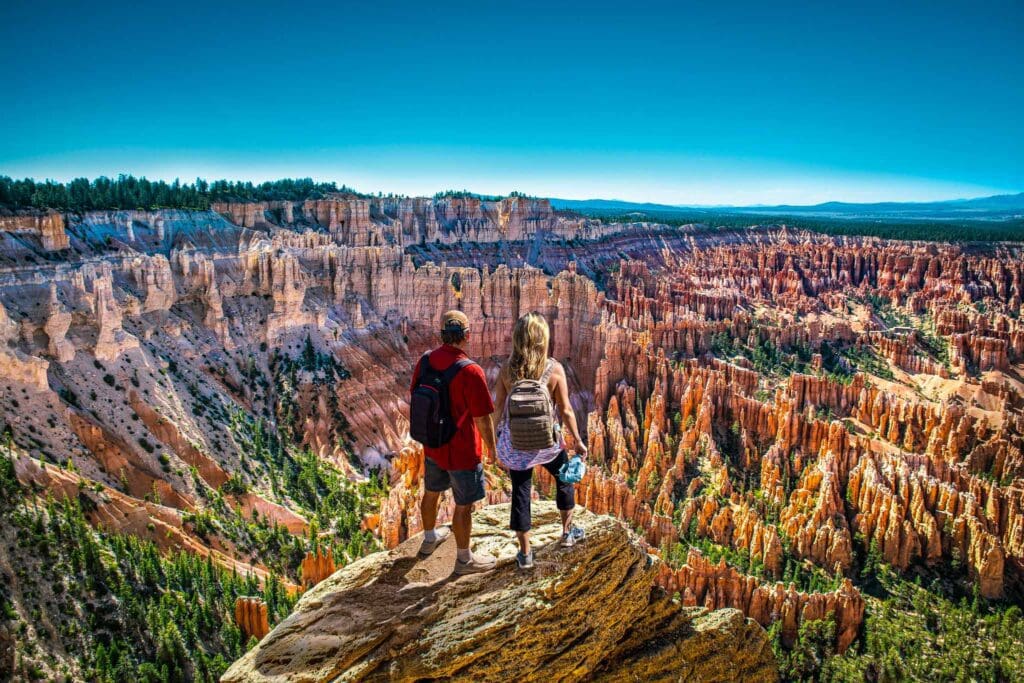
Hikers enjoying the view at Inspiration Point in Bryce Canyon National Park.
Main Attractions
As we’ve already mentioned, the main draw to visit Bryce Canyon National Park is the sweeping panoramic views of the large amphitheaters filled with hoodoos. Overlooks like Bryce Amphitheater, Sunrise Point, Sunset Point, Inspiration Point, and the Swamp Canyon Overlook are not to be missed.
But there are also plenty of individual features you can hike up to that are worth every bit of your time. Notable formations like Thor’s Hammer; a tall freestanding hoodoo, Tower Bridge; an incredible arch between two huge towers, Mossy Cave; a stone overhang draped over by a broad waterfall, and Bristlecone Point require short to moderate hikes to get to.
While visiting the park, it’s a good idea to get around using the park shuttle. While it isn’t mandatory, it reduces congestion, the need for larger parking lots, and reduces human impact on the land. Shuttles run from April through mid-October beginning at 8:00 AM. They run frequently and stop at all the major overlooks and trailheads in the park.
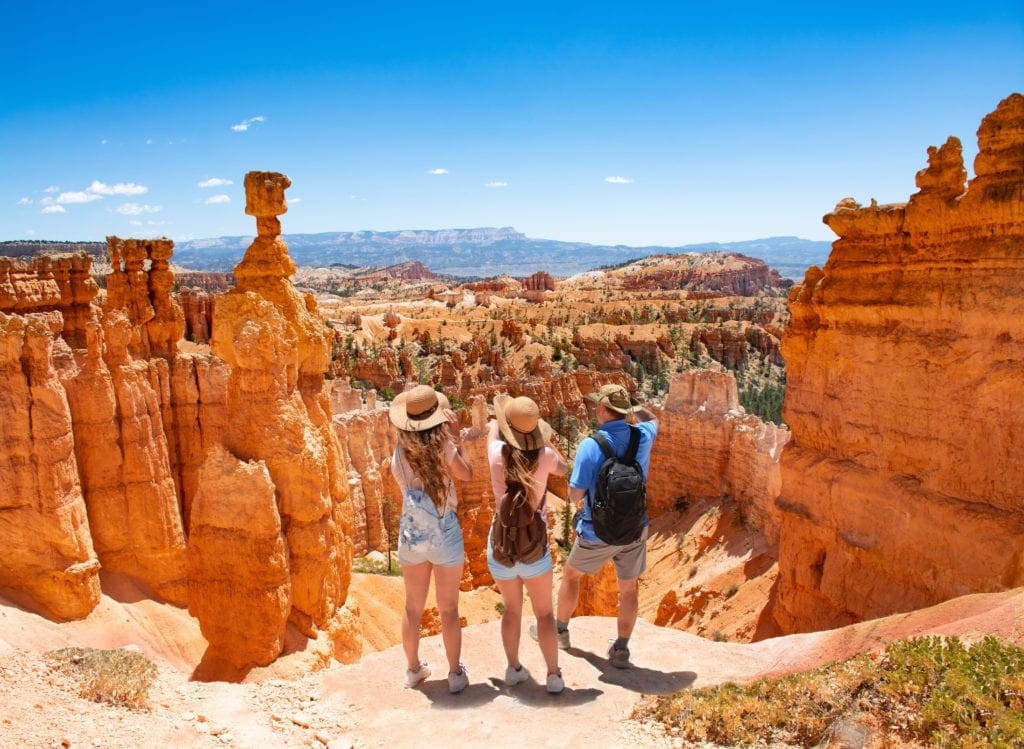
Hikers at the Thor’s Hammer hoodoo in Bryce Canyon National Park.
Hiking
Hiking is the primary fare for recreation in Bryce. Because of how fragile the landscape itself is, more hands-on forms of recreation are mostly off-limits here. But not to worry, there are plenty of amazing hikes to fill your time.
Easy
For beginners or those strapped for time, Bristlecone Loop and Mossy Cave are trails not to miss. They both total less than a mile and climb very little, but promise big payoffs. Mossy Cave is particularly beautiful in the winter, when the ceiling becomes covered in picturesque icicles.
Moderate
Intermediates and those looking to burn a half-day should be sure not to miss the Queen’s Garden/Navajo Loop Combination trail. It’s the most trafficked trail in the park, but don’t let the crowds dissuade you. The trail puts you right in the heart of the action, winding through narrow side canyons and passing features like Queen Victoria, Thor’s Hammer, Two Bridges, and Wall Street. The Tower Bridge trail is also an intermediate hike ascending 800 feet through bristlecone pines to the aforementioned arch.
Difficult
For hikers willing to sacrifice some more sweat, you’ll have the best chance to see the park without the crowds. Fairyland Loop is a prime example; the trail totals eight miles and passes Chinese Wall, Tower Bridge, and imposing hoodoos, with much more room to yourself. Peekaboo Loop Trail is a massive spectacle, entering the heart of the park and passing the Wall of Windows. For a more demanding, but equally rewarding experience, try the Figure 8 Combination. This combines Queen’s Garden, Peekaboo Loop, and Navajo Loop into a single day hike that can be done in four to five hours.
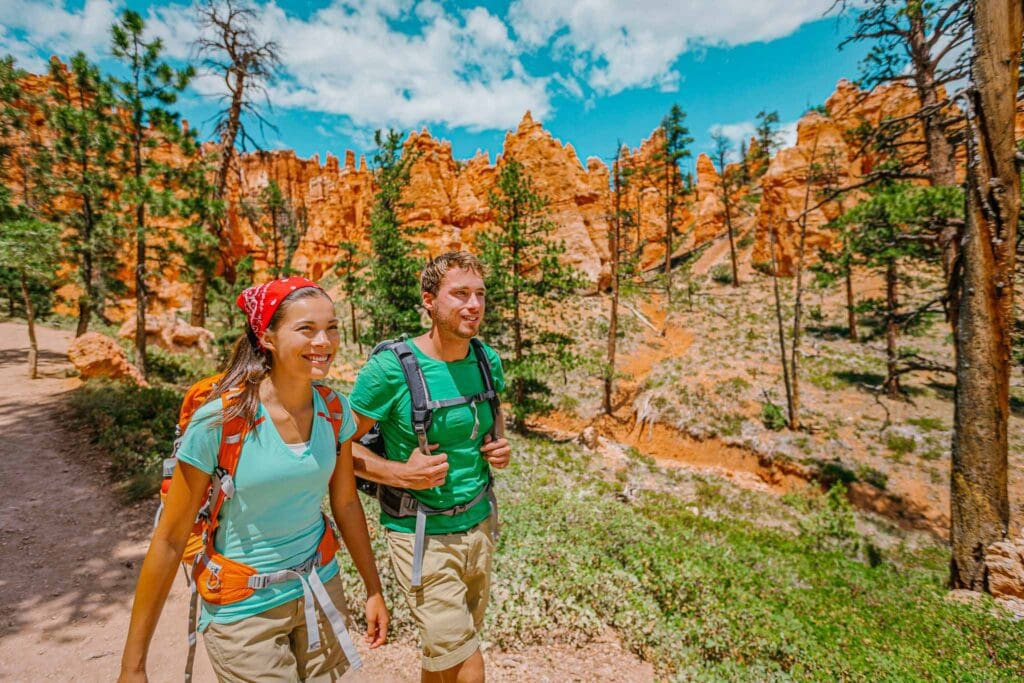
Hikers in Bryce Canyon National Park.
Backpacking
Like most national parks, the best camping experiences are the ones you have to put a little work into. The best way to experience overnighting in Bryce Canyon is backcountry camping. There are two main trails through the Bryce Canyon backcountry where you can camp, and both are superb.
The main backpacking through the park follows the edge of the plateau, traversing the many amphitheaters and ridges of Bryce. This is the Under The Rim Trail, a 22.4 mile one-way trek crossing most of the park. It runs from Yovimpa Point to Bryce Point, and there are seven backcountry campsites along the way to pitch your tent. The trail can be divided into sections, so if you don’t want to commit to the full length, you can do a smaller section in fewer nights. To call the Under The Rim Trail an epic journey may be selling it short – this is probably the best way to experience the park. And when you reach the end, you can take a park shuttle back to where you parked.
The other backpacking route covers much less ground, but in a less commonly traveled part of the park. The Riggs Spring Loop Trail covers just 8.6 miles and has three backcountry sites along the way. There’s also a large group site on a spur trail near Riggs Spring. For a less-committing trail that doesn’t skimp on elevation gain, this is a fantastic way to go. You’ll be guaranteed to see a part of the park that most never get to. And the solitude of the desert is what we’re all after, isn’t it?
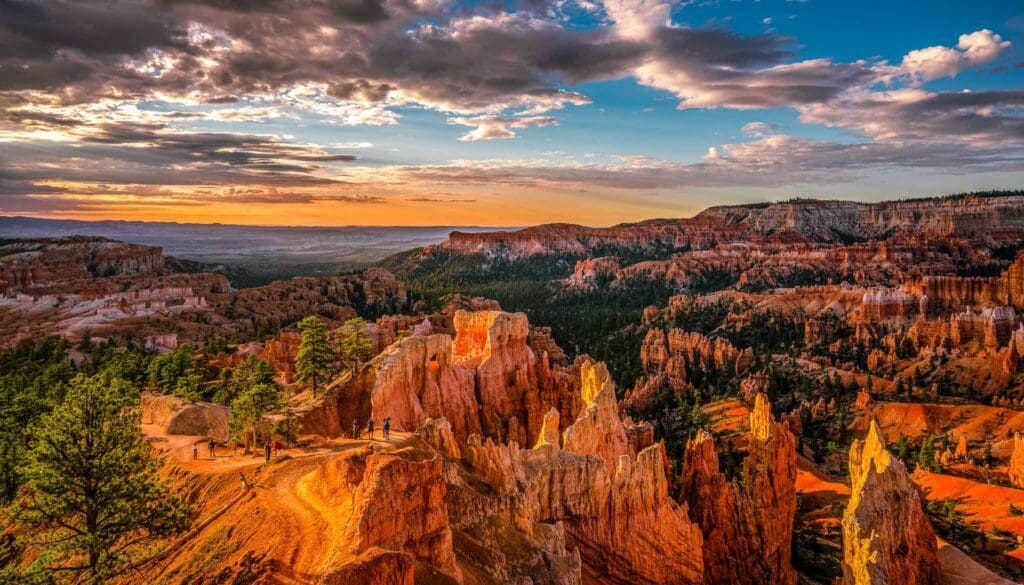
Sunrise view of the Navajo Loop Trail from the Bryce Canyon. Photo by Craig Zerbe/Adobe Stock.
Horseback Riding
It’s also possible to take a guided horseback ride through Bryce Canyon. Canyon Trail Rides, the park’s concessioner, offers 2-hour and 3-hour guided horse and mule rides into the Bryce Amphitheater along a dedicated horse trail and the Peekaboo Loop Trail. Trail rides generally run from April to October, depending on weather. Riding a pack animal through the narrow drainages of Bryce is an unforgettable experience.
If you get the right permits, you can also bring your own horse or mule for pack trips. Get in touch with the park for more details as day trips need to be planned ahead of time with the approval of the park. You can also overnight with your stock just outside park boundaries in Red Canyon and Dixie National Forest.
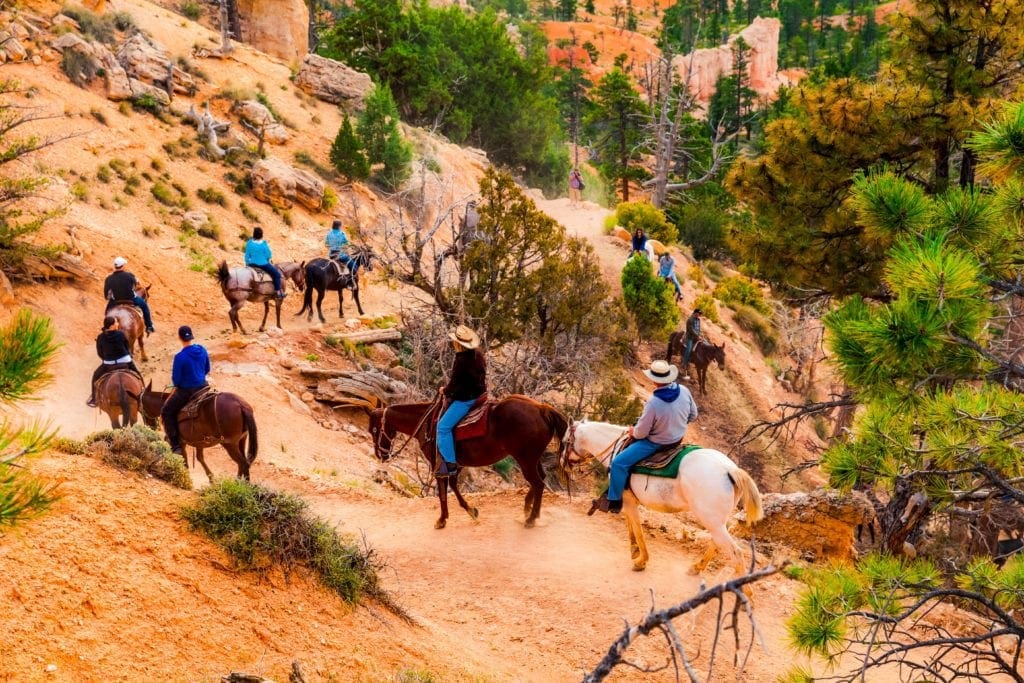
Horses on the hiking trails in Bryce Canyon National Park, Utah. Horse riding tours are popular Bryce Canyon.
Nature Tourism
Bryce Canyon is a gem for all things nature-related. Wildlife watchers, stargazers, and geology fanatics will all be overwhelmed by the majesty of the park. There are birdwatching and stargazing events in the park, as well as an annual geology festival. Regardless of your particular poison, Bryce has got everything a nature nerd could want with an afternoon and a pair of binoculars.
The Bryce Canyon Geology Festival: Every July, Bryce Canyon offers its Geo Fest. Park rangers lead guided hikes, geology programs for all ages are available, as well as evening events and activities at the Visitor Center suited for families with small children.
Each holiday season, Bryce Canyon National Park offers an opportunity for anyone with an interest in nature – from ‘bird enthusiasts’ to casual observers – to help continue the Christmas Bird Count tradition. Bryce Canyon has a variety of routes available that range from easy drives to more demanding hikes, and park rangers will pair you up with other birders that match your skills and physical abilities. Enjoy the outdoors and contribute to the conservation of our national parks by participating in this meaningful event.
Stargazing
Bryce Canyon National Park was officially designated as an International Dark Sky in 2019. Its high elevation, clean air, and remote location make the night skies some of the darkest in the country. On a clear night, you can see up to 7,500 stars and the Milky Way. Rangers lead multimedia programs and stargazing with telescopes in summer months, and there’s a four-day astronomy event. Check out ranger programs for more information.
Bryce Canyon Astronomy Festival: There’s just no comparison with the beauty of Bryce Canyon during the day, and on a new moon night in June it is particularly spectacular. During the astronomy festival, families can enjoy daytime activities and participate in evening programs with telescope viewing and constellation tours.
The park is well known for its astro-tourism activities. Every year there are more than one hundred ranger-led stargazing events, from talks to evening walks and telescope viewings. For the best stargazing experience, be sure to come during the new moon.
On full moon nights, join in on wonderful hikes among the hoodoos. These popular excursions don’t allow flashlights and require “lug traction” footwear. Bookings are limited so check out the Full Moon Hike page for more information.
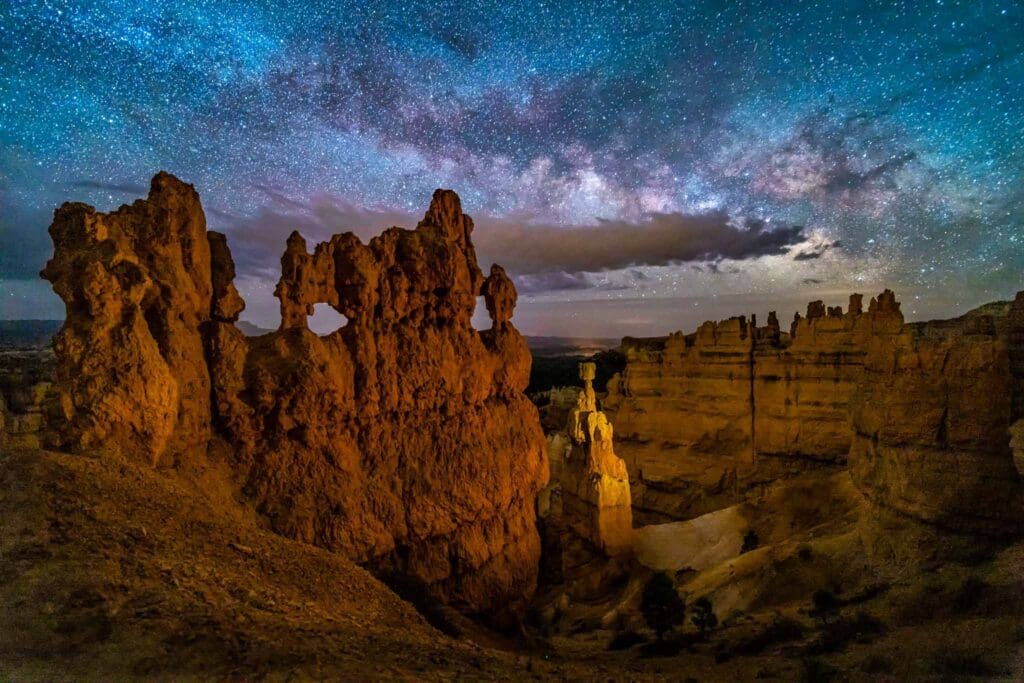
Hoodoos and Thor’s Hammer against a night sky with the Milky Way above Sunset Point in Bryce Canyon National Park.
Treat Yourself To A Guided Adventure
If you’re looking to explore a new activity or deepen your mastery of an existing sport, it pays to invest in a professional. Guides not only ensure your safety when doing something for the first time, but they can also lead you off the beaten path and offer enlightening details about history, culture and geology. Plus, prepare yourself for captivating narratives no one else can tell. To hire an experienced local pro, you can use services such as 57Hours, or REI Adventures.
There are local guides for hiking, backpacking, climbing, canyoneering, mountain biking, ice climbing and backcountry skiing adventures throughout Utah. Journey across the Southwest’s picturesque trails while gaining insight into ancient cultures and learning about Utah’s geology and ecology.
REI Adventures
REI Adventures has created a vast selection of outdoor experiences based in America’s most iconic places, making its U.S. trip catalog over one hundred strong. Here are a few examples of their adventures at Bryce Canyon National Park.
Zion & Bryce Hiking & Camping: This 5-day journey through Southwestern Utah is an ideal hiking and camping adventure, taking us from the Scout Lookout to the majestic Narrows. Camp beneath a starry night sky with fellow travelers, as experienced hikers and novices alike discover the stunning landscapes. The journey promises to be both challenging and comfortable.
Zion & Bryce Canyon Cycling: Join a six-day guided adventure in Zion and Bryce Canyon National Parks, where you’ll cycle, hike, and be amazed by the scenery. REI provides high-quality bikes and full support plus excellent snacks. During the daily rides, marvel at pines on the Red Rock Bike Trail; take on steep inclines of Tunnel Climb; explore Kodachrome Basin; and witness the Mars-like formations of Fairyland. Opt for hikes too as guides shed light on the cultural surroundings. Southern Utah is well worth the trip to witness nature’s glory and weirdness.
Bryce Canyon Easy-Active Hiking and Camping: Escape and unplug with our 3-day getaway to Bryce Canyon National Park. By day, you’ll hike through stunning geological scenery of sandstone spires (hoodoos). And in Grand Staircase-Escalante National Monument, explore slot canyons for a unique backcountry adventure.
Everyone is talking about the REI guides, and we understand why! Discover what makes REI’s tour guides so praised and applauded.
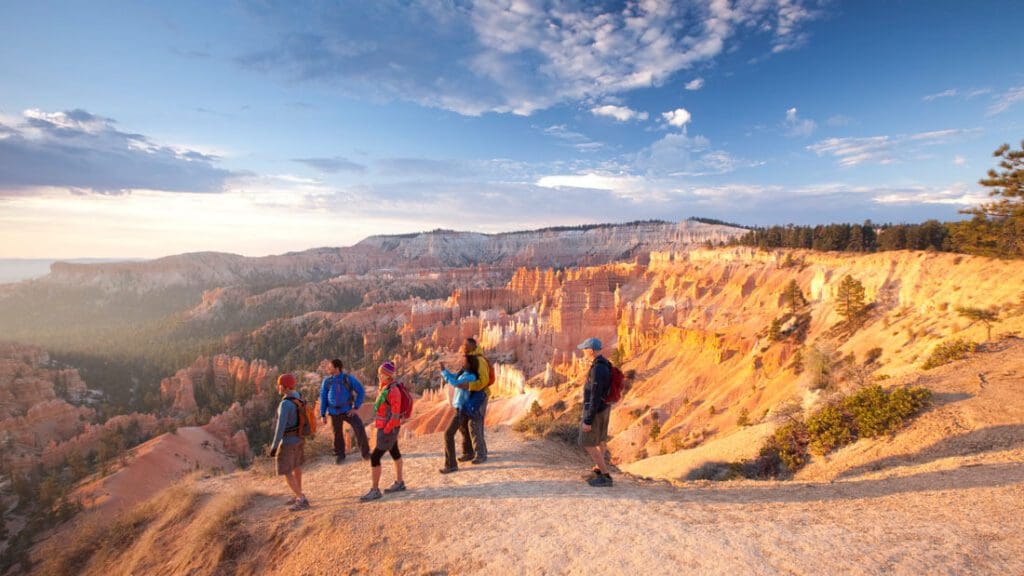
Escape and unplug on REI’s 3-day hiking getaway to Bryce Canyon National Park. Photo by REI Adventures.
57Hours
If you don’t already know, 57hours is a service that connects weekend warriors like yourself with certified, local guides, so you can maximize your enjoyment on your days off. They have a large selection of multi-day hiking, climbing and mountain biking adventures in Utah with local guides. Here are some examples of their many adventures in Bryce Canyon:
Mountain Biking in Bryce Canyon: Bryce Canyon National Park is a mountain biker’s paradise, with routes that take riders through alien-like windows and slot canyons. From Dave’s Hollow to Skunk & Badger to Thunder Mountain, there are rides for all levels of experience. You’re sure to find a favorite ride and will likely be back for more!
Hiking in Bryce Canyon: Bryce Canyon National Park is world-renowned for its hoodoos, unique chiseled rock spires. With 37 different day hikes offering easy strolls and steep treks, hikers enjoy otherworldly views of the surrounding peaks and valleys. The Rim Trail’s sunrise view from Sunrise or Sunset Point is a must-do, as it is a common way to start or end guided tours here.
A Living Landscape
From the squirrels in the trees to the very earth itself, Bryce Canyon National Park is a living and breathing landscape. We are immensely lucky to see it in its present state, as pristine as it is. It’s a shining example of the need for National Parks, and the value of preserving special places for future generations. Not only of humans, but of the many thousands of living things that call this incredible place home. When you visit Bryce Canyon, you’re seeing a snapshot of a place that has taken millions of years to become what it is, and will continue along its journey for millions more. Take a breath, take it all in. It’s not going anywhere.
Enroll With Global Rescue Prior To Embarking On Your Next Adventure.
When a travel emergency arises, traditional travel insurance may not come to your aid, and a medical evacuation can cost up to $300,000.
The cost when you have a Global Rescue membership? $0. That’s why when the unexpected happens, you want the leader in rescue, evacuation and medical advisory behind you. You want Global Rescue.
Popular Articles:
How To Spend 57 Hours in Moab, Utah As A Mountain Climber
Top Adventure Sports Towns: Moab, Utah
Adventurer’s Guide to Zion National Park, Utah
Adventurer’s Guide to Canyonlands National Park, Utah
Adventurer’s Guide To Arches National Park, Utah
Adventurer’s Guide To Capitol Reef National Park, Utah
Adventure Talk: Discover Mountain Biking in Moab, Utah
Guided Backcountry Skiing Adventures in Utah – The Greatest Snow on Earth












